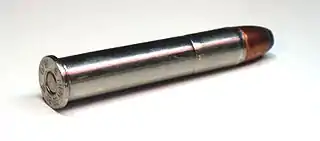| .38-55 Winchester | ||||||||||||||||
|---|---|---|---|---|---|---|---|---|---|---|---|---|---|---|---|---|
 | ||||||||||||||||
| Type | Rifle | |||||||||||||||
| Place of origin | United States | |||||||||||||||
| Production history | ||||||||||||||||
| Designer | Ballard Rifle & Cartridge Company | |||||||||||||||
| Designed | 1884 | |||||||||||||||
| Produced | 1884–present | |||||||||||||||
| Variants | .38-55 Winchester +P[1] | |||||||||||||||
| Specifications | ||||||||||||||||
| Parent case | .38-50 Ballard Everlasting[2] | |||||||||||||||
| Case type | Rimmed, straight | |||||||||||||||
| Bullet diameter | .377 in (9.6 mm) | |||||||||||||||
| Land diameter | .373 in (9.5 mm) | |||||||||||||||
| Neck diameter | .392 in (10.0 mm) | |||||||||||||||
| Base diameter | .421 in (10.7 mm) | |||||||||||||||
| Rim diameter | .506 in (12.9 mm) | |||||||||||||||
| Case length | 2.085 in (53.0 mm) | |||||||||||||||
| Overall length | 2.510 in (63.8 mm) | |||||||||||||||
| Rifling twist | 1 in 18 in (460 mm) | |||||||||||||||
| Maximum pressure (CIP) | 35,000 psi (240 MPa) | |||||||||||||||
| Maximum CUP | 30,000 (Standard Pressure) and 38,000 (+P Pressure) CUP | |||||||||||||||
| Ballistic performance | ||||||||||||||||
| ||||||||||||||||
| Source(s): Whelen, Townsend. The American Rifle. The Century Co.: 1918, p. 272. | ||||||||||||||||
The .38-55 Winchester cartridge (actually .3775 caliber), also known as the .38-55 WCF and the .38-55 Ballard,[4] is a centerfire rifle cartridge. It was based on an earlier cartridge called the .38-50 Ballard Everlasting that was introduced in 1876 by the Ballard Rifle & Cartridge Company. The .38-55 was used in Marlin Firearms from 1876 onwards for various single-shot target rifles and their 1893 lever-action rifle. It was later offered by Winchester in its Model 1894. Winchester continued to use the round in various rifles until about 1940, and also used it in a few commemorative editions of rifles since then. In addition, Marlin offered it in some 336s, and it was used in non-lever action rifles such as the Remington-Lee bolt-action.[5][6] The .38-55 Winchester is also the parent case for the .30-30 Winchester, .32 Winchester Special, and the .375 Winchester cartridges.[7]
A modernized version of the cartridge debuted in 1978 as the .375 Winchester, designed with higher pressures and to be used in modern firearms only. It is not safe to fire factory .375 Winchester ammunition in rifles chambered in .38-55, especially in older examples. The brass is very similar (shortened by approximately 1 mm (.0394 in)), but using modern, higher pressure .375 loads in an older rifle could cause serious injury to the shooter.[8]
The .38-55 is used to hunt black bear and deer at moderate ranges and is also used in cowboy action shooting side matches.
See also
Notes
- ↑ Winchester Model 94 big bore. (n.d.). Retrieved February 24, 2023, from https://chuckhawks.com/win_94_big-bore.html
- ↑ Simpson, L. (2018, October 1). .38-55 winchester. RifleShooter. https://www.rifleshootermag.com/editorial/ammunition_rs_3855winchester_200811/84300
- ↑ Heavy 38-55 winchester rifle ammunition. Buffalo Bore Ammunition. (n.d.). Retrieved February 24, 2023, from https://www.buffalobore.com/index.php?l=product_detail&p=159
- ↑ "38-55 WINCHESTER | Cartridge Collector". Retrieved 2023-12-14.
- ↑ Barnes, Frank C. Cartridges of the World: A Complete Illustrated Reference for More Than 1,500 Cartridges. Iola, Wisconsin: Gun Digest Books. p. 91. ISBN 978-1-4402-3059-2.
- ↑ Sapp, Rick (2007). Standard Catalog of Colt Firearms. Gun Digest Books. p. 288. ISBN 978-0-89689-534-8.
- ↑ ".38-55 Winchester". www.chuckhawks.com. Retrieved 2023-12-14.
- ↑ Thomas Henshaw (1993). The History of Winchester Firearms 1866-1992. Academic Learning Company LLC. p. 232. ISBN 978-0-8329-0503-2.
